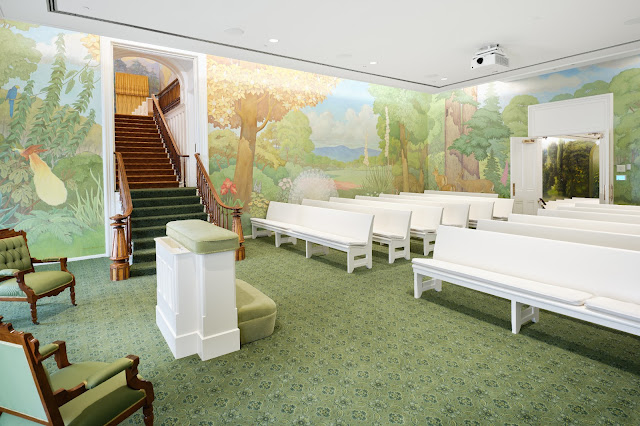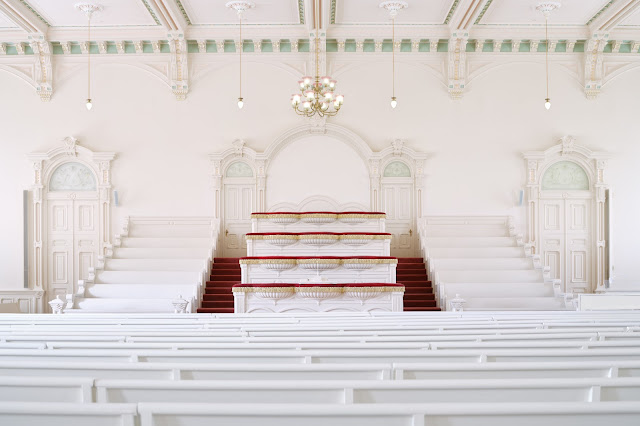With the recent focus on the Manti Temple and the efforts to preserve its murals and progressive form, I wanted to do a post that focused more heavily on the mural in the world room. I have a post on the rest of the temple, but this mural tends to receive the most focus out of all the murals in the temple, because it is so striking. While I cover them briefly, the most detail can be found in this BYU Studies' Article from which most of the pictures are taken.
.jpeg)
In the endowment ceremony, the world room represents the world in which we now live--the world into which Adam and Eve were cast out, full of imperfection and sorrow. Most other world room murals show the world in a fallen state without any humans--animals fighting and desolate landscapes. (Two exceptions are the Los Angeles Temple, which shows Adam and Eve entering the lone and dreary world, and the Idaho Falls Temple, which shows pioneers). Minerva Teichert used a different concept, instead showing how humans have interacted in this fallen world. Her mural ends up being a history of mankind, showing the contrast between those who strive to connect with God and those who do not. Minerva said, "The world has no significance other than people, and that’s what it was created for . . . that’s the story of the world room, it is a ‘people room.'"
Here is the view of the world room as patrons enter from the back. The front of the room is the east wall. The creation and garden rooms are significantly smaller than this room, and as patrons come up the staircase from the garden room into the world room, the effect is breathtaking.
Minerva's mural is basically a history of mankind, beginning on the back (west) wall and moving toward the east.
On the east wall, the Tower of Babel is under construction, one of the earliest stories given in the Bible. From here, just as man was scattered after the tower was destroyed, the story of mankind splits. The south wall (on the left side) shows the history of Israel; the north
wall (on the right side, clearly visible above) shows the history of
the gentiles.
Here is the south wall, which shows the history of Israel.
There are four separate stories here. First, we see Abraham, Sarai, and Lot entering Canaan. This is symbolic
of the Abrahamic covenant and the beginning of Israel.
Next, we see Joseph being
sold into Egypt by his brothers.
Last on the wall, we Moses confronting the people of Israel
who are worshiping a golden calf. Finally, we see a the Pilgrims boarding the Mayflower, awaiting their journey to America. Minerva connected the Pilgrims to Israel: "Israel is embarking to the West for the New World."
On the north wall, Minerva depicted the Gentiles--from the Orient to Europe.
There are 3 groups of people in this pageant--those on animals, those walking, and then those in the foreground, representing the poor, oppressed, and afflicted of this world.
There is a window at the northwest corner of the room which goes directly into the temple's Holy of Holies. Beneath this window, Minerva shows Esau selling a slave.
Next comes the Orient section, showing several people from the far east, bearing symbols of their respective religions.
In the final section of the wall, we see crusaders proceeding in a procession, followed by Christopher Columbus on a ship.
In the foreground are the suffering and oppressed, while the religious and proud pass them by. This includes a blind woman, a father with his homeless family, and a mother with her lame son. Below these figures are some small painted banners with words that are now barley legible. One labels a group "poverty"; another labels them "the least of these." Underneath Columbus is a family driven to emigrate; underneath them, a banner reads "To Earth's End."
Both of these groups--Israel and Gentile--converge at North America, depicted on the west wall, the front of the room. The fact that America is the destination and the gathering place is symbolized by the Native American in the center.
From the south wall comes a Pilgrim seeking religious freedom; from the north wall comes a trader seeking wealth. They represent the different reasons people came here. A Native American stands between the two, already having claimed America as his home. Behind these three contrasting figures stands Zion, brightly lit, high near the ceiling, representative of the ultimate designs of God and destination of mankind. A temple stands in the city. Minerva clarified: "We have not had in mind any city exactly. It could be Salt Lake, Logan, Provo, Bear Lake, Manti, but it is the place where the little stone cut out of the mountain without hands should begin to roll forth until it should cover the whole earth."
Zion is the ultimate destination of the entire populations depicted in the mural; the murals in the story ultimately are about the journey of mankind toward Zion and a higher plane, just as the endowment is about the story of us progressing back toward the presence of God.
While I love the other murals in the temple (the creation room mural is the oldest existing temple mural still in use), this one receives a lot of attention for good reason. It is a unique depiction of the fallen world that opens up insights into the stories of the endowment ceremony. While I am very glad that the Church has promised to preserve the mural and put it on display, removing the mural from its function--highlighting the progress of mankind, as taught in the endowment--it loses some of its value. The form of the mural is less valuable without its function. My hope is that the Church will be willing to keep the mural in the temple so that it can continue to inspire generations.

















.jpeg)
.jpeg)






.jpeg)











.jpeg)





.jpeg)









